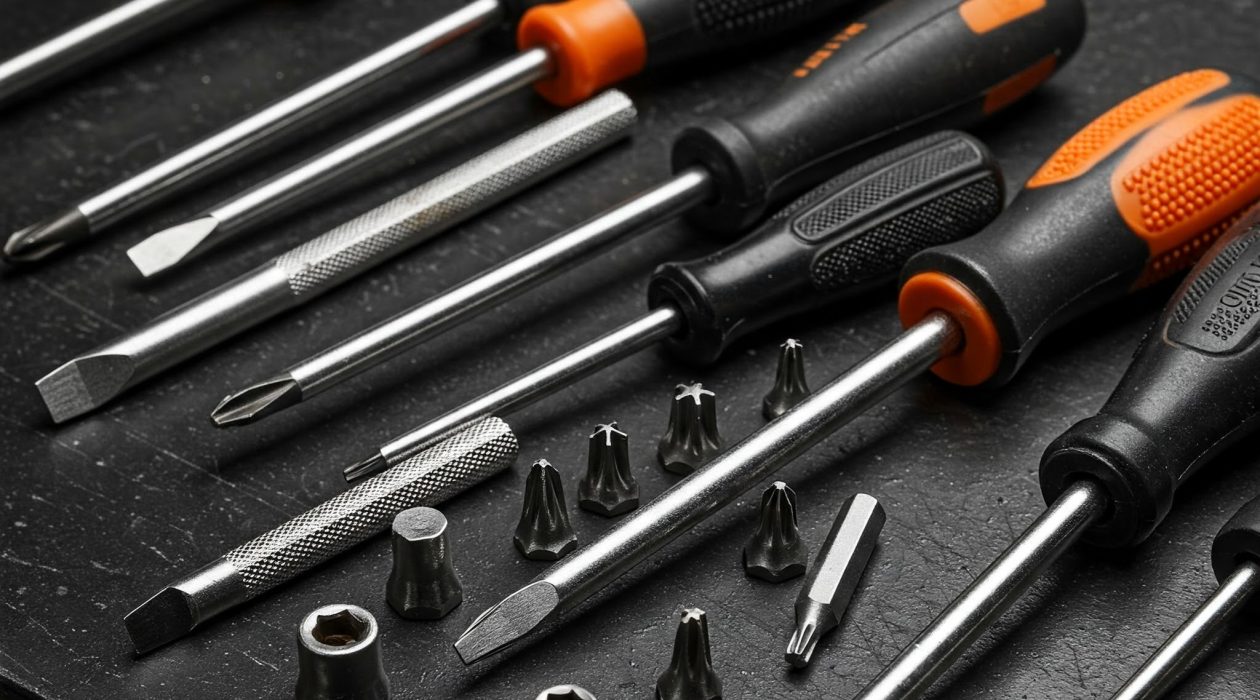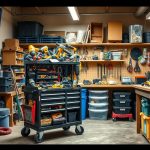In every toolbox, screwdrivers are crucial, and knowing their types and uses is key to success in any project. These tools are vital for driving screws and fasteners. The right screwdriver ensures a job is done well and quickly. With so many options, choosing the right one can be daunting. Yet, with a detailed guide, making the right choice becomes easier.
Knowing the various screwdrivers and their applications helps in selecting the correct tool for any task. This knowledge leads to better outcomes and boosts productivity. Whether tackling a DIY project or a professional task, screwdrivers are indispensable. Grasping their different types and uses is essential for achieving success.
Key Takeaways
- Understanding the different types of screwdrivers is essential for any project
- Screwdrivers are used for driving screws and other fasteners
- Having the right type of screwdriver can ensure that the job is done efficiently and effectively
- There are many types of screwdrivers available, including flathead and Phillips head screwdrivers
- Choosing the right screwdriver can lead to better results and increased productivity
- Types of screwdrivers are a crucial part of any toolbox
- Comprehensive guide can help individuals to make informed decisions and get the most out of their screwdrivers
What Makes a Screwdriver Essential in Every Toolbox
A screwdriver is a fundamental tool, crucial for various tasks from DIY projects to industrial applications. Understanding its importance and components is key for effective screwdriver usage. A good screwdriver guide helps you select the right tool for your needs, ensuring safe and efficient use.
Key components of a screwdriver include the handle, shaft, and tip. Each part has a specific role. The handle offers a comfortable grip, the shaft provides leverage and torque, and the tip drives the screw.
Basic Components of a Screwdriver
The basic components of a screwdriver are designed to work together for a smooth experience. By understanding these components and their interaction, you can use your screwdriver more effectively. This maximizes your screwdriver guide experience.
Understanding Screwdriver Terminology
Understanding screwdriver terminology is crucial for effective screwdriver usage. Terms like torque and drive type are essential for selecting the right screwdriver. Familiarizing yourself with these terms helps you make informed decisions and choose the best tool for your project.
The Evolution of Screwdriver Design
Screwdriver design has evolved significantly, driven by advances in materials and technology. Staying updated with the latest in screwdriver design allows you to benefit from new features and improvements. This enhances your screwdriver usage experience.
Common Types of Screwdrivers Every DIY Enthusiast Should Own
For those diving into best screwdrivers for DIY projects, the right tools are crucial. Every DIY enthusiast needs a set of essential screwdrivers for various tasks. These include flathead, Phillips head, and Torx screwdrivers, each with specific applications.
A best screwdriver for DIY projects should be versatile, durable, and user-friendly. For example, a flathead screwdriver is best for slotted screws. A Phillips head is ideal for cross-shaped screws. Torx screwdrivers, with their star-shaped pattern, are for those screws.
When choosing the best screwdrivers for DIY projects, consider these features:
- Comfortable grip and handle
- Durable materials and construction
- Adjustable torque settings
- Multiple screwdriver bits and sizes
Investing in a set of best screwdrivers for DIY projects ensures you have the right tools. Whether it’s a simple home repair or a complex DIY project, the right screwdrivers are essential.
| Screwdriver Type | Applications | Uses |
|---|---|---|
| Flathead | Slotted screws | General-purpose screwdriving |
| Phillips Head | Cross-shaped screws | Construction, furniture assembly |
| Torx | Star-shaped screws | Electronics, automotive repair |
Phillips Head Screwdrivers: The Universal Standard
Phillips head screwdrivers are essential in every toolbox. They are widely used due to their versatility. These screwdrivers are designed for screws with a cross-shaped slot in the head.
Phillips head screwdrivers come in various sizes, with #2 being the most common. The size of the screwdriver is crucial, as it determines the size of screws it can drive. Having a set of screwdrivers in different sizes is vital.
Different Sizes of Phillips Head Screwdrivers
- #1: Used for small screws, often found in electronics and precision instruments
- #2: The most common size, used for general-purpose screws
- #3: Used for large screws, often found in construction and heavy-duty applications
Understanding the different types of screwdrivers is key to effective use. Phillips head screwdrivers stand out as a universal standard. Their widespread use highlights their versatility and effectiveness.
Common Applications in Home Projects
Phillips head screwdrivers are vital in home projects. They are used for assembling furniture, repairing appliances, and hanging pictures. Their ease of use and versatility make them essential for homeowners and DIY enthusiasts.
| Project | Screwdriver Size |
|---|---|
| Assembling furniture | #2 |
| Repairing appliances | #1 or #2 |
| Hanging pictures | #2 or #3 |
Flathead Screwdrivers: Traditional and Versatile
A screwdriver guide is incomplete without flathead screwdrivers. These tools are traditional and versatile, essential for many DIY tasks. They are often included in the best screwdrivers for DIY, useful for tasks like prying open paint cans or scraping old adhesive.
Flathead screwdrivers stand out with their flat, broad blade and straight handle. This design enables high torque application, perfect for driving large screws or loosening stuck parts. When selecting a flathead screwdriver, focus on the handle’s size and material, as well as the blade’s length and width.
Here are some tips for using flathead screwdrivers:
- Choose the right size for the job to avoid damaging the screw or surrounding material
- Use a screwdriver with a comfortable, non-slip handle to reduce fatigue and improve control
- Consider a screwdriver with a magnetic tip to help keep screws in place
For more information on selecting the best screwdrivers for your DIY projects, consult a reliable screwdriver guide. With the right tools and practice, you’ll become a DIY expert.
By following these tips and choosing the right flathead screwdriver, you’ll confidently tackle a wide range of DIY projects.
| Screwdriver Type | Best Use |
|---|---|
| Flathead | General-purpose DIY projects, prying, scraping |
| Phillips Head | Driving screws with a Phillips head, electronics, construction |
Specialty Screwdrivers for Specific Tasks
Choosing the right screwdriver is crucial for any task. Beyond the usual flathead and Phillips head, there are specialized tools for specific needs. These are vital for precise DIY projects, enhancing any toolkit.
Screwdrivers play a key role in various sectors, from construction to electronics. For example, Torx screwdrivers are a staple in the automotive field. Hex and Allen key screwdrivers are favored in construction and furniture making. Knowing the different types and their applications helps in selecting the correct tool for any project.
Torx Screwdrivers
Torx screwdrivers feature a star-shaped tip, ideal for high-torque applications. They’re widely used in the automotive and aerospace sectors, as well as in electronics assembly.
Hex and Allen Key Screwdrivers
Hex and Allen key screwdrivers are designed for bolts and screws with hexagonal heads. They’re essential in construction and furniture assembly, where high torque is necessary.
Robertson Square Drive Screwdrivers
Robertson square drive screwdrivers are perfect for screws with square sockets. They’re commonly used in construction and furniture making, requiring high torque. Understanding these specialized tools ensures the right choice for any project, making work more efficient.
Electric and Powered Screwdrivers: Modern Solutions
Choosing the best screwdrivers for DIY projects often leads to electric and powered options. These tools offer convenience and efficiency. A detailed screwdriver guide is essential to understand the market’s variety. We’ll discuss the advantages and disadvantages of cordless and corded electric screwdrivers. We’ll also guide you on picking the right power settings for your tasks.
Power settings are crucial in a screwdriver guide. Different projects demand different levels of torque and speed. Knowing how to choose the right power settings can greatly impact your project’s success. For instance, assembling furniture might need lower power, while drilling through concrete requires more.
Top DIY screwdrivers often have adjustable power settings. This allows you to tailor the tool to your project’s needs. When selecting an electric screwdriver, think about your typical projects and the power they require. A reliable screwdriver guide ensures you pick the right tool for the job.
Cordless vs. Corded Options
Cordless screwdrivers offer flexibility and convenience. On the other hand, corded screwdrivers provide consistent power and speed. Evaluate the pros and cons of each to find the best fit for your needs. With the right electric screwdriver and a comprehensive guide, you’re ready to take on any DIY challenge.
Professional-Grade Screwdrivers vs. Consumer Models
In the realm of screwdriver usage, the choice of screwdriver significantly influences project outcomes. Professional-grade screwdrivers stand out for their superior performance and durability, contrasting with consumer models. The primary distinction lies in the materials used, with pros opting for high-carbon steel or other robust materials.
On the other hand, consumer-grade tools often employ lower-quality materials, leading to quicker wear and tear. This is crucial for those engaging in frequent DIY endeavors, where a dependable screwdriver is indispensable. The variety in types of screwdrivers also differs, with professional-grade tools offering a broader spectrum of drive types and sizes.
When deciding between professional-grade and consumer screwdrivers, several factors come into play:
- Material quality: Seek out tools crafted from high-quality materials, capable of withstanding rigorous use.
- Drive type: Assess the nature of your projects and select a screwdriver with the correct drive type (e.g. Phillips, flathead, etc.).
- Size: Opt for a screwdriver with a variety of sizes to accommodate diverse screw types.
Investing in a professional-grade screwdriver ensures DIY enthusiasts have a reliable tool for superior performance and longevity. Whether tackling a minor task or a comprehensive renovation, the appropriate screwdriver is pivotal for screwdriver usage and project success.
| Screwdriver Type | Material | Drive Type |
|---|---|---|
| Professional-Grade | High-Carbon Steel | Phillips, Flathead, etc. |
| Consumer Model | Lower-Quality Materials | Limited Drive Types |
Maintaining and Caring for Your Screwdrivers
To maximize the lifespan of your screwdrivers, proper maintenance and care are crucial. Regular cleaning and storage are key to preventing damage and wear. This ensures your tools remain in top condition for DIY projects.
Following a screwdriver guide’s advice, clean your tools after each use. Use a soft cloth and a mild soap solution to remove debris or residue. Store them in a dry, cool area, away from sunlight to prevent rust and corrosion.
Wear and tear on screwdrivers can manifest as rust, corrosion, or damage to the handle or tip. If you spot these signs, it’s time to consider replacing your screwdriver. Using the right screwdriver for the task and avoiding over-tightening can also prolong their life.
Cleaning and Storage Tips
- Use a soft cloth to clean your screwdrivers
- Store your screwdrivers in a dry, cool place
- Avoid exposing your screwdrivers to direct sunlight
Signs of Wear and When to Replace
Regularly check your screwdrivers for signs of wear, such as rust or corrosion. Replace them as needed to ensure they perform optimally and safely.
| Screwdriver Type | Cleaning Method | Storage Tips |
|---|---|---|
| Phillips Head | Soft cloth and mild soap solution | Dry, cool place |
| Flathead | Soft cloth and mild soap solution | Away from direct sunlight |
Common Mistakes to Avoid When Using Screwdrivers
Many people make simple mistakes when using screwdrivers, leading to damaged screws, stripped heads, or even injury. One major error is using the wrong type of screwdriver for the task. With numerous types of screwdrivers available, selecting the right one is crucial.
Excessive force can strip screws or damage surrounding surfaces. It’s vital to keep your screwdrivers in good condition. Store them properly and clean them regularly to prevent rust and corrosion.
Other mistakes to avoid include:
- Using a screwdriver with a loose or worn-out handle, which can cause loss of control
- Not keeping screwdrivers organized, leading to wasted time searching for the right one
- Ignoring safety precautions, such as wearing protective eyewear or keeping loose clothing tied back
By avoiding these common mistakes, you can ensure safe and effective screwdriver usage. Always choose the right types of screwdrivers for the job and follow safety guidelines to prevent accidents and damage.
With practice and patience, you can master using screwdrivers and complete any project. Remember to use your screwdriver wisely and avoid common mistakes next time.
Choosing the Right Screwdriver for Your Project
When selecting screwdrivers for DIY projects, material type is key. A good screwdriver guide can help you understand the options. For wood, a flathead screwdriver is best. For metal or plastic, a Phillips head is ideal.
Material choice is crucial in picking the right screwdriver. Size and fit guidelines are also vital for performance and to prevent damage. A screwdriver that’s too small or too large can cause stripped screws or damage surfaces.
Professional Recommendations
Experts, both contractors and DIY enthusiasts, suggest using high-quality, durable, and versatile screwdrivers. Look for those with ergonomic handles, magnetic tips, and adjustable torque settings. Consider these factors when choosing a screwdriver:
- Material: Pick a screwdriver that matches the material you’re working with.
- Size: Choose a screwdriver that fits well in your hand and is right for the task.
- Quality: Go for a high-quality screwdriver that can withstand wear and tear.
By following these tips and using a reliable screwdriver guide, you’ll ensure you’re using the best tools for your DIY projects. Always pick a screwdriver that fits the task, and invest in a quality one for longevity.
Safety Considerations and Best Practices
When engaging in screwdriver usage, safety must be paramount. With numerous types of screwdrivers at our disposal, understanding proper handling is vital to prevent accidents. Ensuring correct handling and storage is key to avoiding injuries and maintaining a safe workspace.
To guarantee safe screwdriver usage, adhere to these essential guidelines:
- Always select the appropriate type of screwdriver for the task
- Ensure your workspace is clean and well-lit
- Steer clear of using screwdrivers near open flames or sparks
- Securely store screwdrivers in a dry, safe location when not in use
It’s also crucial to remain aware of your environment when wielding screwdrivers. Be cautious of loose clothing, long hair, or other items that could entangle with the screwdriver. By adhering to these straightforward guidelines, you can significantly reduce the risk of accidents and maintain a secure working environment.
Remember, safety is a collective responsibility. By exercising caution and adhering to screwdriver usage best practices, you safeguard yourself and those around you. Always treat types of screwdrivers with care and never employ them in a manner that jeopardizes your safety or that of others.
| Screwdriver Type | Safety Precaution |
|---|---|
| Phillips Head | Use in well-lit areas to avoid stripping screws |
| Flathead | Avoid using near open flames or sparks |
| Power Screwdriver | Keep loose clothing and long hair tied back |
Mastering Your Screwdriver Collection
Our guide has shown the importance of having the right screwdrivers for any DIY project. From the classic Phillips head and flathead to the specialized Torx and Robertson, each tool has its own role. They are crucial for the success of your home projects.
Mastering your screwdriver collection goes beyond just having many tools. It’s about knowing each tool’s unique features and when to use them. Choosing the right size and material is also key. Following safety guidelines ensures you use them correctly.
By diving into the world of screwdrivers and trying out different types, you’ll find what works best for you. This knowledge will prepare you for your next home improvement project. With the right tools and skills, you’ll complete the job efficiently.


